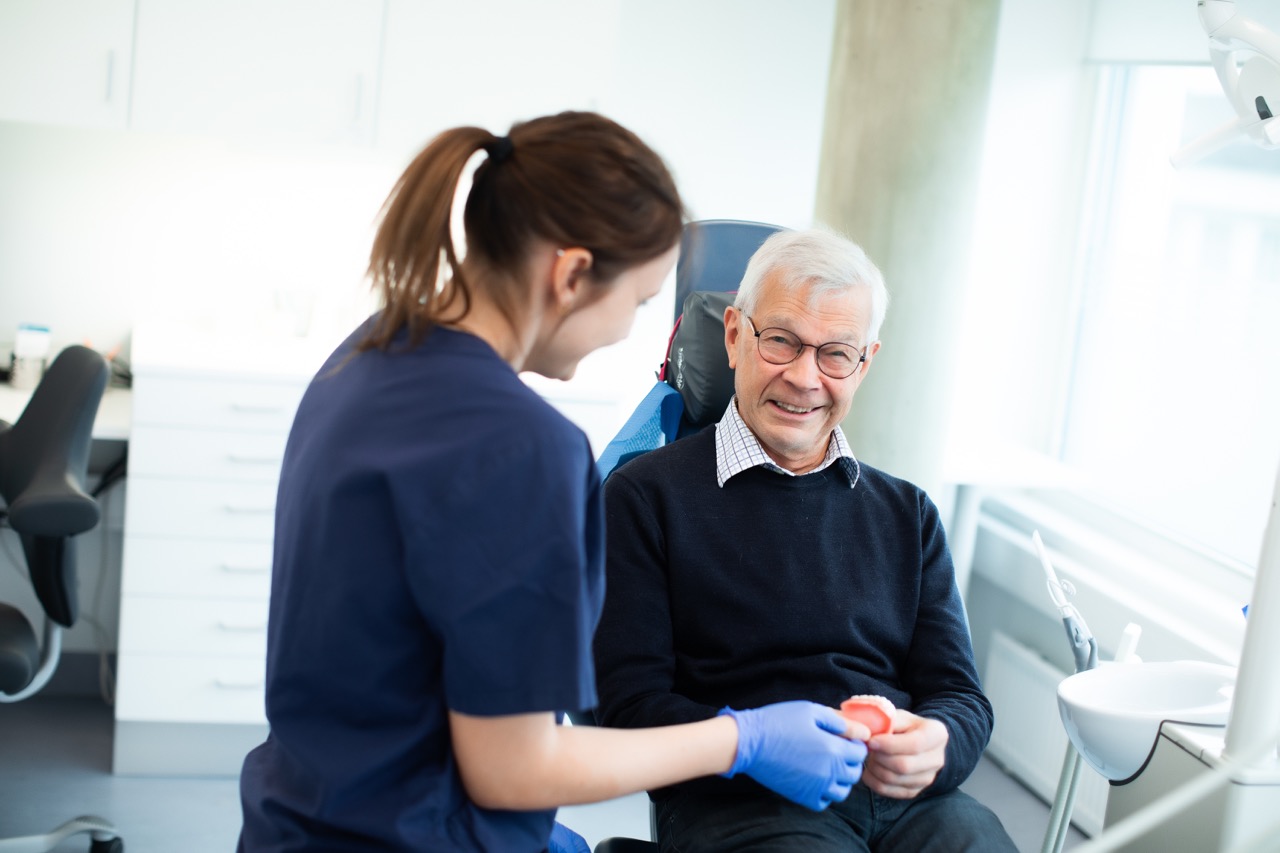Periodontitis
Information about periodontitis, prevention and treatment.

Periodontitis is a chronic inflammatory disease that can occur in the tissues surrounding the teeth.
This is a brochure that tells you more about periodontitis and how you can prevent or take care of your dental health in a good way in case of periodontitis. Fresh gums are pink and sit tight to the teeth. Brushing your teeth and keeping your mouth clean will keep your gums fresh. Over the course of their lives, almost everyone will develop some form of gingivitis, or gum inflammation. This is the body's own way of letting the plaque and bacteria remain and that cleaning should be improved.
What is gingivitis?
Gingivitis (inflammation of the gums) occurs when the daily bacterial coating that forms on the teeth has not been removed (e.g. by missing teeth brushing). Gingivitis is visible in the mouth in that the gum edge, along the teeth, is reddish and swollen and you can bleed easily when brushing your teeth or flossing. To prevent gingivitis, it is important to brush well morning and evening, and get good dental health routines. In this way, you contribute to the fact that the bacterial coating does not remain on your teeth. Gingivitis is a reversible condition and the condition (gingivitis) can be removed with good cleaning.
If the bacterial coating is left untouched in the mouth over time, it can calcify and turn into tartar. Tartar is slightly rough in the surface and therefore more bacteria can attach, and the bacterial coating will grow. Tartar adheres to the teeth and cannot be removed by brushing your teeth. Removal of tartar must be done at the dentist or dentist.
What is periodontitis?
Periodontitis is a gum disease caused by bacterial coating and tartar in the gum pockets, as above time, leads to the attachment of the tooth and the jaw bone to be damaged. When the bacterial coating gets on the teeth and gets deeper into the gum pocket, this can damage the jaw bone. This can occur without you noticing.
With untreated periodontitis, you will lose bone mass in the jawbone, and the teeth will have poorer attachment in the jaw. To stop the development of the disease, the cause must be eliminated, this is done at the dentist or dental hygienist.
Anyone who has periodontitis needs to have a thorough cleaning to prevent further development of the disease, with loss of jaw bones. Especially since the jawbone can not grow back. The goal of treatment at the dentist or dental hygienist will be to provide the patient with the tools they need to prevent the development of the disease and the loosening of teeth.
Periodontitis is an irreversible condition, that is, if the disease has occurred, there will be permanent damage to the jawbone and the attachment of the tooth. Unlike gingivitis, which is a reversible condition, and the condition (gingivitis) can be removed with good cleaning.
How to prevent periodontitis?
Good hygiene is necessary to successfully stabilize or prevent further development of periodontitis. Regular cleaning at home, such as brushing 2-3 times a day, for at least 2 min per time, and the use of interdental brushes are an important part of preventing further development of periodontitis.
Some lifestyle habits or diseases can help influence periodontitis, such as smoking and uncontrolled diabetes. To stabilize the development of periodontitis, it is important to be motivated to change habits and to become smoke-free. Smoking can hinder blood flow in the gums, which is why smokers will not detect gingivitis as quickly.
Consult with your dentist or dental hygienist for more information, and what you can do. They can also show you how to get the best possible result with your teeth brushing and where your areas of development are located.
How is periodontitis treated?
Periodontitis is treated by a dental hygienist, dentist or specialist, depending on the severity or treatment plan. The first thing the clinician starts with is to provide the patient with good information, chart health and habits, and provide training to maintain good oral care at home.
The cause of the disease must be treated. If the gums are kept fresh and the plaque/tartar is removed regularly, one can avoid the development of periodontitis. It will then be possible to keep the disease at bay. Tartar can form more easily in some patients, and especially in those who smoke.
If the patient follows the course of treatment and regular cleaning of the tooth surfaces is done, it will be possible to have a good prognosis of treatment. But there are reasons that can give a worse prognosis on periodontitis treatment.
Periodontitis requires good follow-up care both by the therapist and you as a patient. Regular hours will be set up for cleaning/checking and in some cases other measures will also be needed. Your dental hygienist, dentist or specialist will inform you about this and guide you on the way forward.
Your therapist can also provide cost estimates and you can create a treatment plan together.
Recommendations for cleaning
- Daily cleaning between the teeth, for example with interdental brushes.
- Electric brush or regular toothbrush, with good technique
- Thorough brushing, 2-3 times a day, at least 2 min each time
Refunds
Chapter 6 of the Danish National Insurance Act provides the right to benefits for “Treatment of marginal periodontitis and periimplantitis” and “Rehabilitation in case of tooth loss due to grave marginal periodontitis”. Deductibles for these treatments are included in the “healthcare free card”. Talk to your dentist or dentist if you have any questions.
More subjects

Information material on elderly dental health

Teaching scheme for healthcare professionals

Dental care for the elderly

Full prosthesis

First visit to the dental clinic








